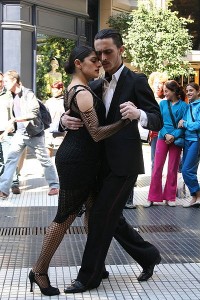We have an interesting piece for you today. One of the three principal forms of Argentine Tango, along with Tango and Milonga, is Tango Vals.
Some History
The European Waltz is much older than tango. It is one of the very first dances (the others being the polka and tango) in which the couple face and touch each other when dancing.
The Waltz was transformed into an independent, identifiable dance only at the end of the 1700s. Couples suddenly started embracing each other, hands were placed around the bodies, and couples looked into each other’s eyes. When the waltz became fashionable in Vienna around 1773, it was shocking to the masses and the aristocrats, and was considered ‘riotous and indecent’ as late as 1825.
Waltz is defined as a dance of German origin performed by couples with rotating and gliding movements. It is accompanied by a music in 3/4 time, generally with 16-bar phrases, at a fast tempo.
The word Creole (Criollo in Spanish) described those working class Argentinians of “old stock”, often descendants of mixed race Spanish and Afro background. The term was somewhat negative, inferring someone who had lived for so long in Argentina that they had gone native. In the same way as Tango Criollo (the tango danced by the native Creoles) was the primitive and first form of tango, there also appeared what is called Vals Criollo (also known as Vals Cruzado).
The immigrants that entered Argentina naturally brought dances and music from their native countries. One of these dances was the Viennese Waltz. In fact by we know that by 1810, the European waltz was being danced in Argentina. As Vals Criollo continue to evolve, so did Tango Criollo in parallel, with Tango Criollo morphing into Tango itself around 1880. In Buenos Aires, the tango musicians of the day – who by and large would have had considerable exposure to the Waltz and its derivative the Vals Criollo – incorporated it into their repertoires. In fact by 1910, quite a few composers were writing tango composition in 3/4 time, and the Tango Vals was born!
One interesting difference between the Tango and the Tango Vals was its intended audience; in the early 1900s Tango was played for and danced by the lower classes, the Tango Vals was adored by the aristocrats and upper class. As they did with other dance forms such as the Candombé, Cuban Habanera and the Polka, the Creoles began to incorporate and thus modify the Waltz being influenced by the environment of Argentina. Thus towards the middle of the 1800s was born the Creole variation of Waltz – the Vals Criollo.
Musicality
I came across this interesting comment. I do so have to spend more time on musicality.
The tempo is the same … however, in Tango Vals, you typically don’t step on every beat. (You do once in a while, but not often).
If the count is:
1 2 3, 1 2 3, 1 2 3, 1 2 3 ; 1 2 3, 1 2 3, 1 2 3, 1 2 3;
You typically step
1 , 1 , 1 , 1 ; 1 , 1 , 1 , 1 ;
Or
1 2 , 1 , 1 2 , 1 ; 1 2 , 1 , 1 2 , 1 ;
Or
1 , 1 3, 1 , 1 ; 1 3, 1 , 1 , 1 3 ;
Or
1 2 3, 1 , 1 2 3, 1 ; 1 2 3, 1 , 1 2 3, 1 ;
In other words, you typically sometimes step on the in-between beats, but rarely do you step on all of them.
Some points of interest
– The music is incredibly gorgeous and more cheerful and joyous than tango often is. There are superb Vals compositions by Roberto Firpo, Juan Maglio, Francisco Canaro, De Angelis, D’Arienzo, Francisco Lomuto, and Troilo.
– The movement is continuous and there are no pauses. Even the hesitations involve movement.
– Much of what you know from tango is transferable.
Enjoy this Video Demonstration of Tango Vals.
Prepared by Dance with me Toronto student Patrick Ashby – thank you!!!

